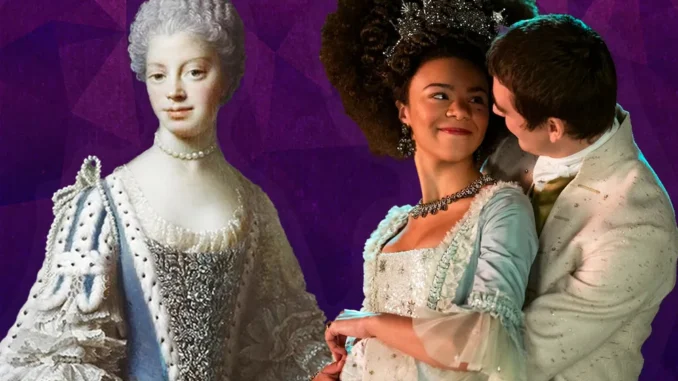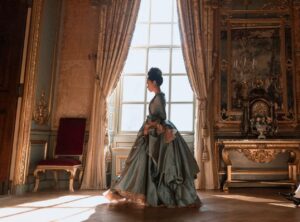
The new spinoff follows the royal matriarch as she falls in love with George III and navigates his worsening mental illness
When Princess Charlotte of Mecklenburg-Strelitz first met George III in 1761, she “threw herself at his feet” in supplication, prompting the English king to raise her up, embrace her and lead her through the garden “up the steps into the palace, ” as one observer recounted. Just a few hours later, the German princess married George, becoming England’s newest queen.
In poor health following a rough voyage at sea, Charlotte was so thin she could barely support the weight of her diamond-adorned wedding gown. As art collector and author Horace Walpole wrote in a letter the following day, “Her violet-velvet mantle and ermine [were] so heavy that the spectators knew as much of her upper half as the king himself.”
Despite this somewhat inauspicious start, Charlotte and George enjoyed an enjoyable, fruitful partnership that endured until the king’s mental illness violently transformed his personality in the late 1780s. Now, a new spinoff of Netflix’s popular historical drama “Bridgerton” is revisiting the royal couple’s love story. Titled “Queen Charlotte: A Bridgerton Story,” the six-episode limited series stars India Amarteifio as the young queen and Corey Mylchreest as her husband.
Golda Rosheuvel, who played an older Queen Charlotte in “Bridgerton,” reprized her role in a parallel storyline set in the 1810s. Today, these years are known as the Regency period, named for the window in which Charlotte’s son, the future George IV, ruled as regent in lieu of his father, whom Parliament had considered mentally unfit.
Black Britons in “Bridgerton”
Like its sister show, “Queen Charlotte” takes considerable liberties with the historical record, portraying Charlotte as a Black woman whose marriage opened doors for people of color in 18th-century England. (In truth, most historians reject the theory that Charlotte was Black.) As Black aristocrat Lady Agatha Danbury says in “Bridgerton,” “We were two separate societies divided by color until a king fell in love with one of us.”

The new series expands on this imagined movement toward racial equality, explaining that George’s mother, Princess Augusta, hastily bestowed titles upon wealthy Black families in order to “remake the nobility in her [new daughter-in-law’s] image,” as Alison Herman writes for Variety. Dubbed the “Great Experiment,” the integration attempt isn’t immediately successful. Herman notes, “There’s some resistance from the old guard, though it’s never explicitly racist, again begging some follow-ups about the preexisting status quo.”
Racial relations in Georgian England were far more complicated than “Bridgerton” and “Queen Charlotte” suggestions. According to Historic England, around 15,000 Black people lived in the country during the second half of the 18th century. The majority of these individuals worked in the domestic service as either paid or enslaved servants. Although Britain abolished the slave trade in 1807—in no small part due to the efforts of Black abolitionists like Ignatius Sancho and Olaudah Equiano—slavery remained legal in the British colonies until 1833, and an exploitative practice in which newly freed adults were forced to work as apprentices for years remained in place until 1838.
“Bridgerton” takes place at a time when “diversity as we know what the word means did not exist,” historian Marlene Koenig tells Insider’s Mikhaila Friel and Ayomikun Adekaiyero. While the show’s producers and stars have framed its inclusion of Black characters as a form of escapism and fantasy, the fact remains that slavery not only exists in the “Bridgerton” world but is also directly responsible for generating much of the wealth on display.
“You can’t say race isn’t of consequence when the world these characters inhabit were created in part through racism,” wrote critic Carolyn Hinds for the Observer in 2021. “Yes, slavery exists in this world, so how could race not matter? Having Black people strolling around in the background doesn’t erase that, and it’s not enough.”
The debate over Charlotte’s Black ancestry
The idea that Charlotte was Black stems from research conducted by historian Mario de Valdes y Cocom. Writing for PBS Frontline in 1997, he argued that Charlotte was “directly descended” from Margarita de Castro y Sousa, a 15th-century Portuguese noblewoman who was herself related to the 13th-century ruler Afonso III and his Moorish lover Madragana. Valdes further pointed to “the African characteristics evident in so many of the queen’s portraits” as proof of his theory, noting that “artists of that period were expected to play down, soften or even obliterate features in a subject’s face, especially a woman’s, that were not considered to meet the standards of beauty for the times.”
